North Africa: Revisiting the British Lists for Mid-War Flames of War
By Richard Steer
The North African campaign has always been the theatre of World War II that I have been most interested in, and specifically the British perspective of the conflict. This interest carried over into , with British forces in the Mediterranean has been my primary focus in the game.
To be honest, I was pretty disappointed with the first releases for FOW V4. Desert Rats and felt very lightweight compared to the previous lists for the African Campaign that we had been playing with, being the original North Africa compilation from 2009. That’s not to say that the V4 lists were bad. On the contrary, with the exception of the 17/25pdr anti-tank gun, Desert Rats was a reasonably historical representation of the most common British armored formations in Egypt and Libya in the middle of 1942. The British lists from Desert Rats were later expanded and re-released as Armoured Fist, which filled in many of the gaps, but the fact remained that the army lists had taken a step backward in detail and completeness under V4.
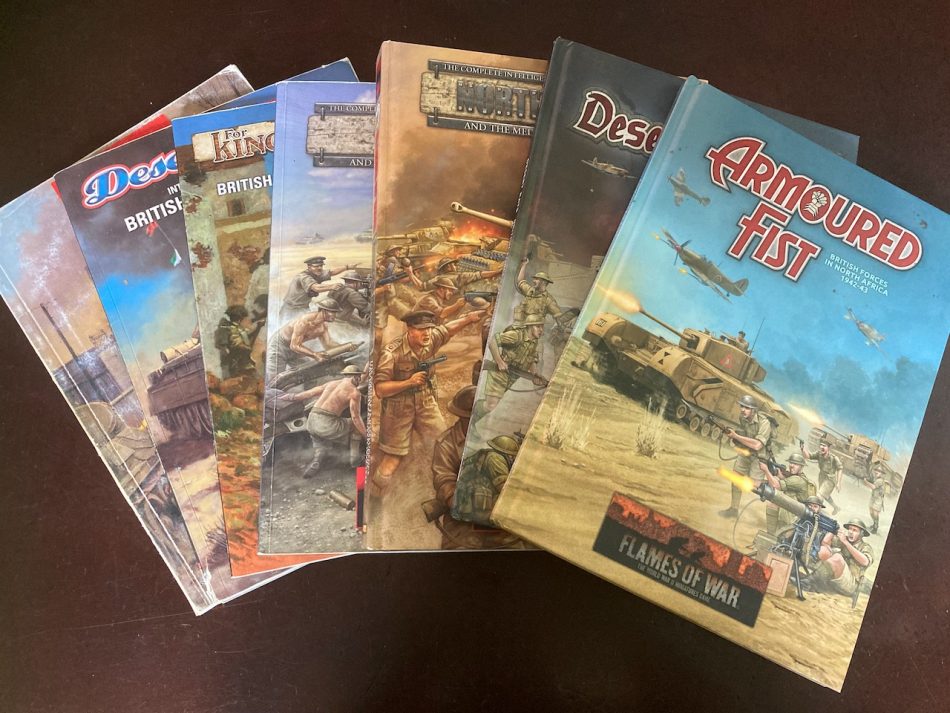
In contrast, the British lists in the original V2 North Africa were brilliant. The book split the Mid-War period into three separate theatres: Africa, Tunisia, and Italy. Each company type had separate lists for each theatre, all restricted to the historically available equipment, and there was a range of obscure units to choose from that helped capture the unique flavor of the theatre. It wasn’t perfect as there were some odd combinations that you could make for Africa, but on the whole it did an excellent job of guiding you towards building a historical force.
is the latest publication for Flames of War. Like the original, this book consolidates existing Mid-War books for the Mediterranean theatre into a single volume. The British lists are largely an exact reprint of Armoured Fist and Red Devils, with no new historical units, and the only additions being . I had hoped for more, but as this book is what the Mid-War Brits are going to look like for the foreseeable future, it seemed appropriate to take another look in detail at the British lists from the 2009 North Africa, stepping through each list from the three theatres to see how closely they can be built in V4 using the new North Africa.
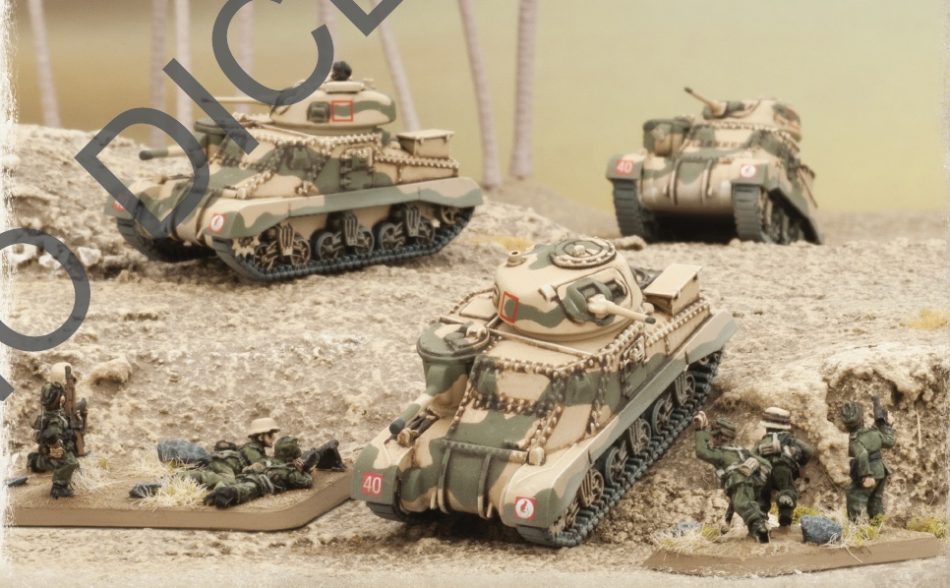 Africa
Africa
The Africa theatre represents the Western Desert campaign, following Eighth Army in its battles with the Germans and Italians in Egypt, Libya, and Tunisia.
Heavy Armoured Squadron: Whereas this was once a single list with the option of Shermans or Grants, it is now represented by two separate formations, the Sherman and Grant Armoured Squadrons. The Light Armoured Platoons that were formerly Weapons Platoons are no longer in the Formation, so if you want them then they either need to be a single platoon taken as Formation Support or multiple platoons fielded as a Light Armoured Squadron.
Light Armoured Squadron: This is also split into two formations, the Crusader or Honey Armoured Squadrons. You can influence the way they play by adding either the Cavalry Commander or Scout Tanks command cards. Cavalry Commander encourages movement by permitting shooting after a successful Follow Me order, while Scout Tanks does the opposite, supporting more cautious play.
Motor Company: The Motor Company has variations that can be created using the Guards Motor Company or Indian Motor Company command cards. The differences between the two editions are the removal of the 2pdr anti-tank gun, and the Motor Platoons only having one anti-tank rifle instead of three. Sticky Bombs are available to all infantry and gun units via a command card. The Kingforce Churchill Platoon from V2 can be taken as a single Churchill Tank Platoon via Formation Support, or as a separate Churchill Armoured Squadron (using Shermans as the second compulsory platoon) if you want to field all six of the Churchill tanks that were in the theatre.
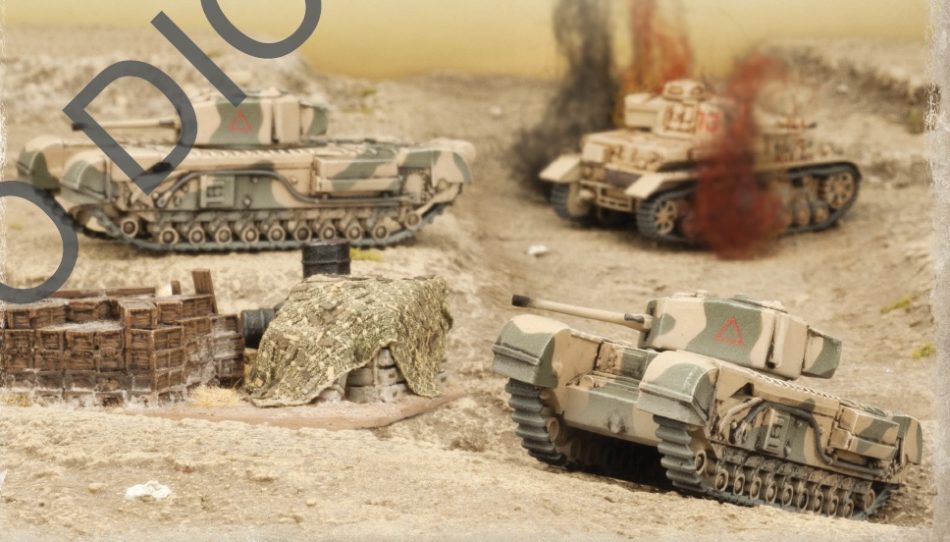 Rifle Company: The Rifle Company retains most of its variations, which can be created using the ANZAC Rifle Company, Indian Rifle Company, South African Rifle Company, or Bagpiper command cards, but loses the Gurkha and Maori sub-variants. The formation also loses the option of having 2pdr anti-tank guns, the Pioneer Platoon, Heavy Mortar Platoon, Matilda Scorpion, and some equipment specific to the Indian variant.
Rifle Company: The Rifle Company retains most of its variations, which can be created using the ANZAC Rifle Company, Indian Rifle Company, South African Rifle Company, or Bagpiper command cards, but loses the Gurkha and Maori sub-variants. The formation also loses the option of having 2pdr anti-tank guns, the Pioneer Platoon, Heavy Mortar Platoon, Matilda Scorpion, and some equipment specific to the Indian variant.
Infantry Tank Company: This is now the Valentine Armoured Squadron. The Matilda is not in the book but is available as a Community Card. Once again you can favor different play styles for the Valentines by applying for different command cards: Infantry Support improves their performance in Assaults, while Charge! makes them play like heavily armored Crusaders by giving them Tally Ho and a longer Tactical move, which can then be stacked with Cavalry Commander for a further speed boost.
Divisional Cavalry Squadron: This isn’t in the book itself but is created using the Australian Divisional Cavalry or New Zealand Divisional Cavalry command cards, both of which closely match the original list.
Armoured Car Squadron: This is created by the Humber Armoured Car Squadron or Daimler Armoured Car Squadron command cards, but they lose the Jeep Platoon and Scout Squad that they used to have. There is currently no option for using Marmon Herrington or AEC armored cars under V4.

Tunisia
The Tunisia theatre follows the British elements of First Army, from the Operation Torch landings in November 1942 through to the surrender of the Axis forces in Tunisia in May 1943.
Armoured Squadron: This is the standard Sherman Armoured Squadron. The Recce Troop from the V2 list is created by including a Honey Armoured Troop with Scout Tanks.
Rifle Company: All of the V2 variants are available through the Guards Rifle Company, Indian Rifle Company, Bagpiper, and White Knees command cards. Once again they are missing the option of having 2pdrs, Pioneers, and Heavy Mortars.
 Motor Company: The Tunisian version of the Motor Company used to have the option of having a third Motor Platoon, which is now not possible. Apart from that, the same comments apply as with the Africa version: there are no 2pdr anti-tank guns and fewer anti-tank rifles.
Motor Company: The Tunisian version of the Motor Company used to have the option of having a third Motor Platoon, which is now not possible. Apart from that, the same comments apply as with the Africa version: there are no 2pdr anti-tank guns and fewer anti-tank rifles.
Infantry Tank Company: This is represented by the Churchill Armoured Squadron. Their play can be modified by the Mad Tanks command card which effectively gives them an auto Cross.
Death or Glory Squadron: This keeps its own formation as the Death or Glory Armoured Squadron, retaining the same structure as the original list. It can be modified by a couple of command cards: Death or Glory gives its units a better Last Stand, which can also be combined with Cavalry Commander.
 Parachute Company: The Tunisia version of the Parachute Rifle Company would not include any of the Airlanding support units. The major change between editions is that they are now rated as Careful Fearless Trained instead of Fearless Veteran, although they are still Assault 3+. They have kept their Section Mortars and can use the Sticky Bombs command card, but no longer have Sniper teams.
Parachute Company: The Tunisia version of the Parachute Rifle Company would not include any of the Airlanding support units. The major change between editions is that they are now rated as Careful Fearless Trained instead of Fearless Veteran, although they are still Assault 3+. They have kept their Section Mortars and can use the Sticky Bombs command card, but no longer have Sniper teams.
Commando: This is the Commando Troop in the new book. They no longer have the option of including SMG teams but retain most of their special rules, including Assault 2+ and the ability to cross impassable cliffs.
Armoured Car Squadron: This is created using the Mailed Fist Armoured Car Squadron command card. As this is a unit created by a Formation Build command card, the Mailed Fist Armoured Car Troop is not available outside of this formation.
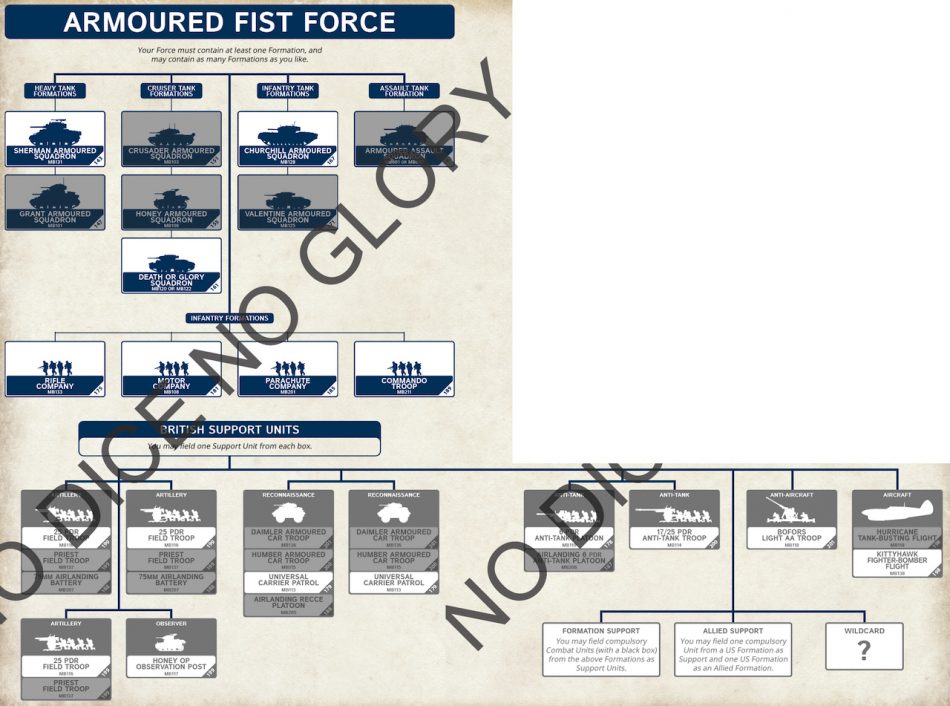
Italy
The Italian theatre includes the landings in Sicily and Italy and the fighting in Italy through to the end of 1943.
Armoured Squadron: The Italian version of the Armoured Squadron is the same as in Tunisia. There are no longer the variations in ratings that there were available under V2, with no Confident Veteran version, and no command cards representing Canadian armor.
Rifle Company: The optional variations available for the Rifle Company include the Guards Rifle Company, ANZAC Rifle Company, Indian Rifle Company, and Bagpiper command cards. Once again there is no command card for the Canadians, but the card that best matches the Canadian rules from V2 is ANZAC Rifle Company. The formation no longer has Pioneers, Heavy Mortars, and the 20mm anti-aircraft platoon.
Motor Company: The V2 version of the Italy Motor Company is built using the Rifle Company list, using minimum-sized Rifle Platoons and an optional variation from the ANZAC Rifle Company command card. The only unit it is missing is the 20mm anti-aircraft platoon. The normal Motor Company is also a valid historical option which is now available under V4, but wasn’t under the old V2 lists.
Parachute Company: The Parachute Rifle Company for Italy would have the full range of Airlanding units available to it.
 Commando: The Commando Troop for Italy is the same as that for Tunisia.
Commando: The Commando Troop for Italy is the same as that for Tunisia.
Armoured Car Squadron: This can be built using either the Humber Armoured Car Squadron or Daimler Armoured Car Squadron command cards. There is currently no option to use the Staghound armored car under V4, and they have also lost the 75mm Gun, Scout Car, Dingo, and Anti-aircraft Platoons.
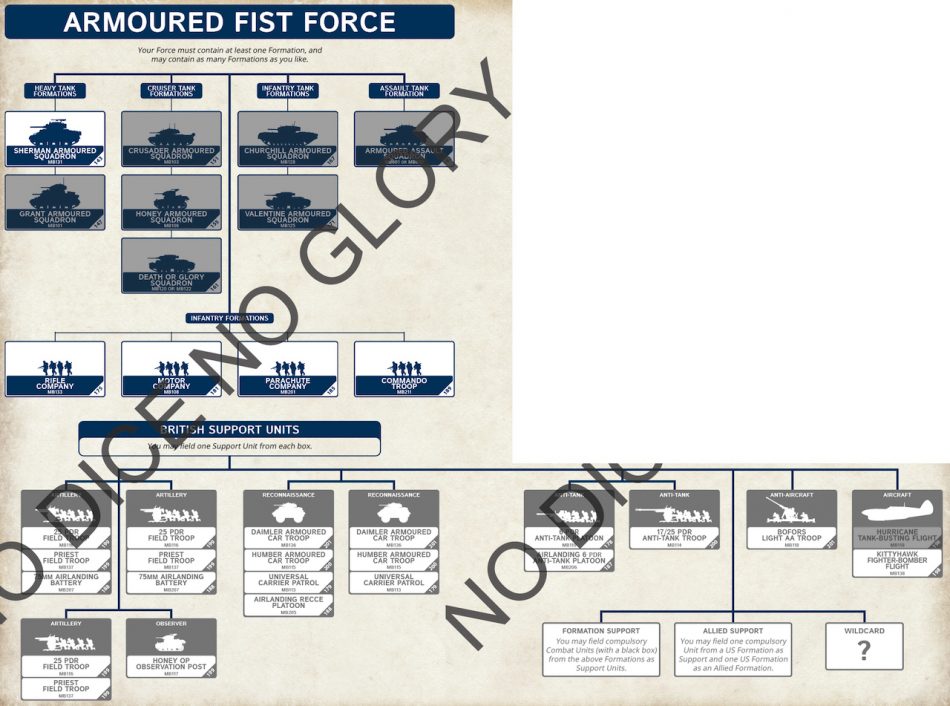
What’s Missing?
Running through the difference between the two books, the most obvious gaps are in the reconnaissance options. There are no Recce Squadrons, and there are three Armoured Car Squadron variants that are no longer included. I can understand the reasoning behind this decision: there is only so much space in the book and on shop shelves, armored cars have always been a niche formation, and there are already three variants available.
The and Bishop, while not in the book, are available as Community Cards, and the same approach could be taken to add support for the other units that the game has previously included:
- Recce Squadrons and the missing armored cars.
- The 4.2-inch mortar for Rifle Companies across all three theatres.
- The Blacker Bombard and Indian Pattern Carrier for the Indian Rifle Company
- The 2pdr Portee, Matilda Scorpion, Deacon, and 3.7″ anti-aircraft gun for Africa.
- The 20mm AA, Autocar 75mm SP, and White Scout Car for Italy.
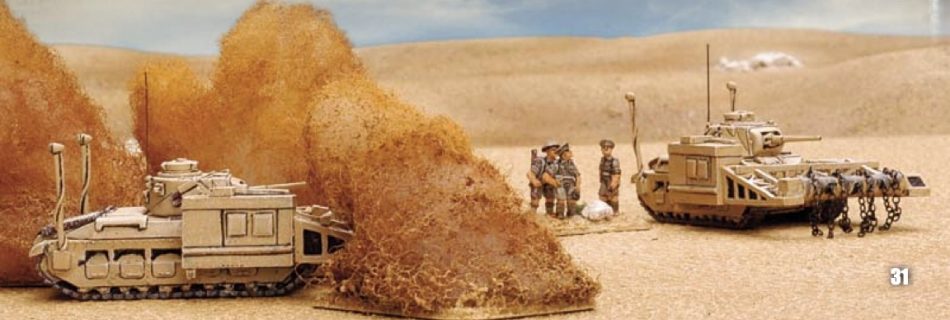
Reflections
When I first read through the new North Africa compilation, I was disappointed that the British lists hadn’t been expanded beyond Armoured Fist. Having gone through the book again in detail, I’m now pretty excited about a return to Mid-War.
To be clear, this excitement is not about the book itself, because none of the new content is of interest to me. Rather, it has reminded me that the lists that have been migrated from Armoured Fist into the compilation are solid. The variety of historical options that are available is almost as wide as it was under the old version of the book, but it does take more effort to go through the combination of lists and command cards than it did when all of the lists were pre-packaged. For some forces, the command cards increase the variety by creating alternative ways of playing certain lists.
North Africa doesn’t have everything that I could want in it, but on the whole, the Mid-War British lists are in a good place. There are some gaps that could be filled with additional Community Cards, and I still believe the game would benefit from Battlefront finding a way to rebalance some of the points. I’m looking forward to playing Mid-War again, and I’m already plotting what I could do with the . It’s going to be fun.
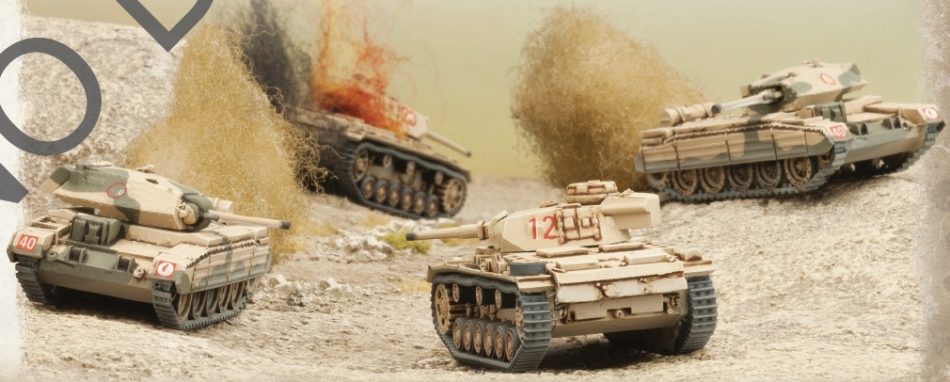

So the 6th AD still can’t take a troop of its own Armoured Car Regiment , as a support unit !!!!!
That’s my reading of the rules, if you want them then you have to spend 9pts getting the minimum formation. Having three Spearhead units isn’t necessarily a bad thing game-wise, but it would be nice to have the option of taking a single troop as support.
Compared to the old North Africa book the new book is a bit disappointing. It feels like a typical cost/effort calcualtion how to release something new with minimum investment. A compilation is always nice, but BF missed a lot of opportuinities here. The recent LW books were way better.
The re-release of the Mid War Monsters is a nice thing, but to be honest they are just a odd bonus.
I hope that BF will find an opportunity to include older units like Deacon. They at least had some combat use compared to MWM.
Great and thorough article Richard. Thank you for poposing options under V4.
Thank you! This helps sort out what l planning to do for my midwar desert units. Looking over different command cards and books you truly given us better insight to build our forces.